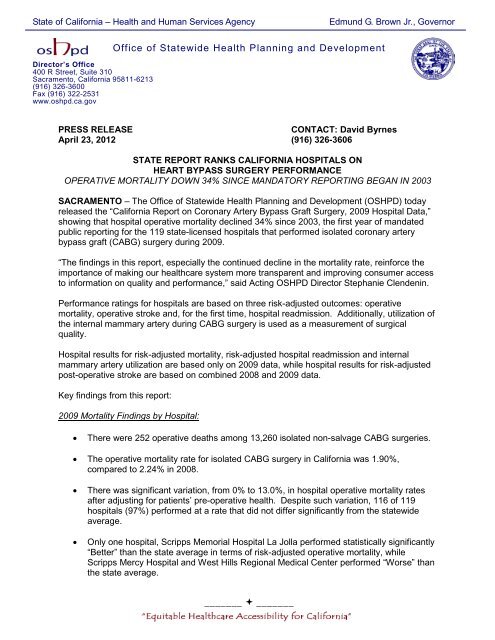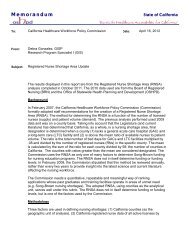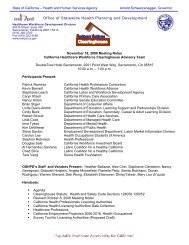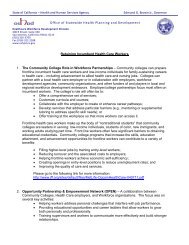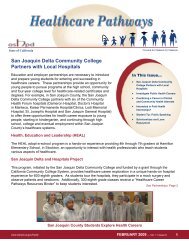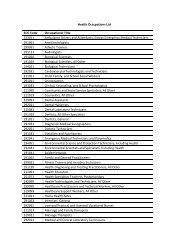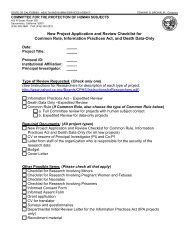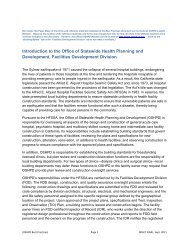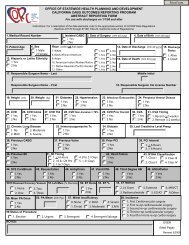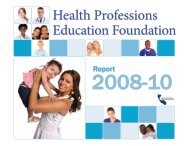State Report Ranks California Hospitals On Heart Bypass Surgery ...
State Report Ranks California Hospitals On Heart Bypass Surgery ...
State Report Ranks California Hospitals On Heart Bypass Surgery ...
Create successful ePaper yourself
Turn your PDF publications into a flip-book with our unique Google optimized e-Paper software.
<strong>State</strong> of <strong>California</strong> – Health and Human Services Agency<br />
Edmund G. Brown Jr., Governor<br />
Director’s Office<br />
400 R Street, Suite 310<br />
Sacramento, <strong>California</strong> 95811-6213<br />
(916) 326-3600<br />
Fax (916) 322-2531<br />
www.oshpd.ca.gov<br />
Office of <strong>State</strong>wide Health Planning and Development<br />
PRESS RELEASE<br />
CONTACT: David Byrnes<br />
April 23, 2012 (916) 326-3606<br />
STATE REPORT RANKS CALIFORNIA HOSPITALS ON<br />
HEART BYPASS SURGERY PERFORMANCE<br />
OPERATIVE MORTALITY DOWN 34% SINCE MANDATORY REPORTING BEGAN IN 2003<br />
SACRAMENTO – The Office of <strong>State</strong>wide Health Planning and Development (OSHPD) today<br />
released the “<strong>California</strong> <strong>Report</strong> on Coronary Artery <strong>Bypass</strong> Graft <strong>Surgery</strong>, 2009 Hospital Data,”<br />
showing that hospital operative mortality declined 34% since 2003, the first year of mandated<br />
public reporting for the 119 state-licensed hospitals that performed isolated coronary artery<br />
bypass graft (CABG) surgery during 2009.<br />
“The findings in this report, especially the continued decline in the mortality rate, reinforce the<br />
importance of making our healthcare system more transparent and improving consumer access<br />
to information on quality and performance,” said Acting OSHPD Director Stephanie Clendenin.<br />
Performance ratings for hospitals are based on three risk-adjusted outcomes: operative<br />
mortality, operative stroke and, for the first time, hospital readmission. Additionally, utilization of<br />
the internal mammary artery during CABG surgery is used as a measurement of surgical<br />
quality.<br />
Hospital results for risk-adjusted mortality, risk-adjusted hospital readmission and internal<br />
mammary artery utilization are based only on 2009 data, while hospital results for risk-adjusted<br />
post-operative stroke are based on combined 2008 and 2009 data.<br />
Key findings from this report:<br />
2009 Mortality Findings by Hospital:<br />
• There were 252 operative deaths among 13,260 isolated non-salvage CABG surgeries.<br />
• The operative mortality rate for isolated CABG surgery in <strong>California</strong> was 1.90%,<br />
compared to 2.24% in 2008.<br />
• There was significant variation, from 0% to 13.0%, in hospital operative mortality rates<br />
after adjusting for patients’ pre-operative health. Despite such variation, 116 of 119<br />
hospitals (97%) performed at a rate that did not differ significantly from the statewide<br />
average.<br />
• <strong>On</strong>ly one hospital, Scripps Memorial Hospital La Jolla performed statistically significantly<br />
“Better” than the state average in terms of risk-adjusted operative mortality, while<br />
Scripps Mercy Hospital and West Hills Regional Medical Center performed “Worse” than<br />
the state average.<br />
_______ _______
2008-2009 Post-operative Stroke Findings by Hospital:<br />
• Of the 27,217 patients who underwent isolated CABG surgery, 384 (1.41%) experienced<br />
a post-operative stroke, similar to the national rate of 1.4% reported by the National<br />
Society of Thoracic Surgeons.<br />
• There was wide variation in post-operative stroke rates among hospitals after adjusting<br />
for patients’ pre-operative health. Hospital risk-adjusted stroke rates ranged from 0% to<br />
8.87%, and 114 of 121 hospitals (94%) performed at a rate that did not differ significantly<br />
from the statewide average.<br />
• For the third report in a row, Alta Bates Summit Medical Center performed statistically<br />
“Better” than the state average in terms of risk adjusted post-operative stroke rates and<br />
was among three hospitals with high marks. There were also four hospitals that<br />
performed “Worse” than the state average.<br />
2009 Hospital Readmission Findings by Hospital:<br />
• Of the 11,823 patients who underwent isolated CABG surgery and were discharged<br />
alive, 1,565 (13.2%) experienced a hospital readmission within 30 days of the surgery.<br />
• There was wide variation in the readmission rates among hospitals performing CABG<br />
surgery after adjusting for patients’ pre-operative conditions. Hospital risk-adjusted readmission<br />
rates ranged from 0% to 29.77%, and 117 of 119 hospitals (98%) performed<br />
at a rate that did not differ significantly from the statewide average.<br />
• <strong>On</strong>e hospital, Queen of the Valley, performed “Better” than the state average on hospital<br />
readmission, and one hospital, San Joaquin Community Hospital, performed “Worse”<br />
than the state average.<br />
OSHPD is committed to “Equitable Healthcare Accessibility for <strong>California</strong>.” OSHPD analyzes<br />
and supports the state’s healthcare infrastructure, promoting medical care transparency for<br />
<strong>California</strong>ns. OSHPD also supports a diverse and culturally competent workforce, ensures<br />
safety of buildings used to provide healthcare, insures loans to develop healthcare facilities, and<br />
facilitates development of a sustained capacity for communities to address their healthcare<br />
concerns.<br />
The <strong>California</strong> <strong>Report</strong> on Coronary Artery <strong>Bypass</strong> Graft <strong>Surgery</strong>, 2009 Hospital Data is available<br />
at www.oshpd.ca.gov.


